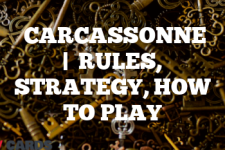Java (Board Game): Unbeatable Strategies, Rules, and Winning Instructions
Introduction
Java, a board game that has been captivating players since its inception, is a strategic game that requires careful planning and tactical execution. The game is set in the island of Java, where players are tasked with developing the land, building palaces, and expanding their influence. The game was designed by Michael Kiesling and Wolfgang Kramer and was first published in 2000 by Ravensburger. The equipment needed to play Java includes a game board, tiles, action points, and player pieces.

Rules for playing Java
The rules of Java are straightforward yet offer a depth of strategy that keeps players engaged. The game is played on a 5×5 grid, with each player starting with a set number of action points. Players can use these points to perform various actions such as placing tiles, moving their figures, or building palaces. The game continues until all tiles have been placed, at which point the player with the most points wins. While the official rules provide a balanced and challenging game, players may also choose to implement ‘house rules’ to add variety or adjust the difficulty.
How do you play Java
- Setup: Each player starts with a set number of action points and player pieces. The game board is empty at the start of the game.
- Gameplay: Players take turns using their action points to perform actions. These actions can include placing tiles on the board, moving their figures, or building palaces. Each action costs a certain number of points.
- End of the Game: The game ends when all tiles have been placed on the board. Players then tally their points, with points awarded for the size of their palaces, the number of figures in their largest group, and their remaining action points. The player with the most points wins.
How to Win at Java (board game)
Winning at Java requires a balance of strategic planning and tactical execution. Here are some strategies that can help you win:
- Plan Ahead: Always have a plan for your next few moves. This will allow you to use your action points efficiently and set up advantageous positions.
- Control the Board: Try to control the central areas of the board. This will give you more options for placing tiles and building palaces.
- Build Big: Larger palaces score more points, so try to build as big as you can. However, be careful not to overextend and leave yourself vulnerable to attacks from other players.
Best Strategies for playing Java
Here are some of the best strategies for playing Java:
- Balance Your Actions: Don’t focus too much on one type of action. A balanced approach will give you more flexibility and options.
- Be Flexible: Be ready to change your plans based on the actions of other players. Adaptability is key in Java.
- Use Your Points Wisely: Action points are a precious resource. Make sure to use them wisely and get the most value out of each point.
Scenarios for Java (board game)
Here are some common scenarios you might encounter in Java, and how to turn them to your advantage:
- Blocked by Other Players: If other players are blocking your plans, try to find ways to work around them. You might be able to find a different path to your goal, or you can use your action points to move their figures.
- Running Low on Action Points: If you’re running low on action points, consider focusing on actions that give you the most value. For example, building palaces can score you a lot of points for a relatively low cost.
- Falling Behind in Points: If you’re falling behind in points, don’t panic. There are many ways to catch up, such as building large palaces or creating large groups of figures.
Frequently Asked Questions about playing Java (board game)
Q: How many players can play Java? A: Java can be played by 2 to 4 players.
Q: How long does a game of Java typically last? A: A game of Java typically lasts between 60 to 120 minutes.
Q: Can I move other players’ figures? A: Yes, you can use your action points to move other players’ figures. However, this can be costly in terms of action points.
Q: What happens if I run out of action points? A: If you run out of action points, you cannot perform any more actions until your next turn, when you receive more points.
Q: Can I build a palace on any tile? A: You can only build a palace on a tile if it is connected to one of your figures.
External Links
For more information about Java, visit the official game website here.

A digital native around since the early days of online gaming communities around 2001. An early contributor to the cult gaming site ClanTemplates, Adam has spent years giving free gaming resources to the community. With BoardCards, Adam is most experienced and commonly writing the articles on Strategy multi-player games like Settlers of Catan and Avalon. His first introduction to board games was via Mancala, an Egyptian-origin stone game and one of the oldest known games still played worldwide. Contact me via email



